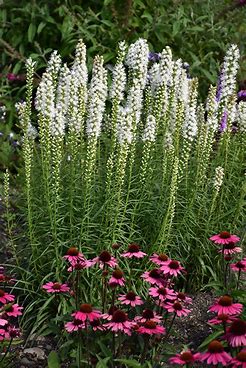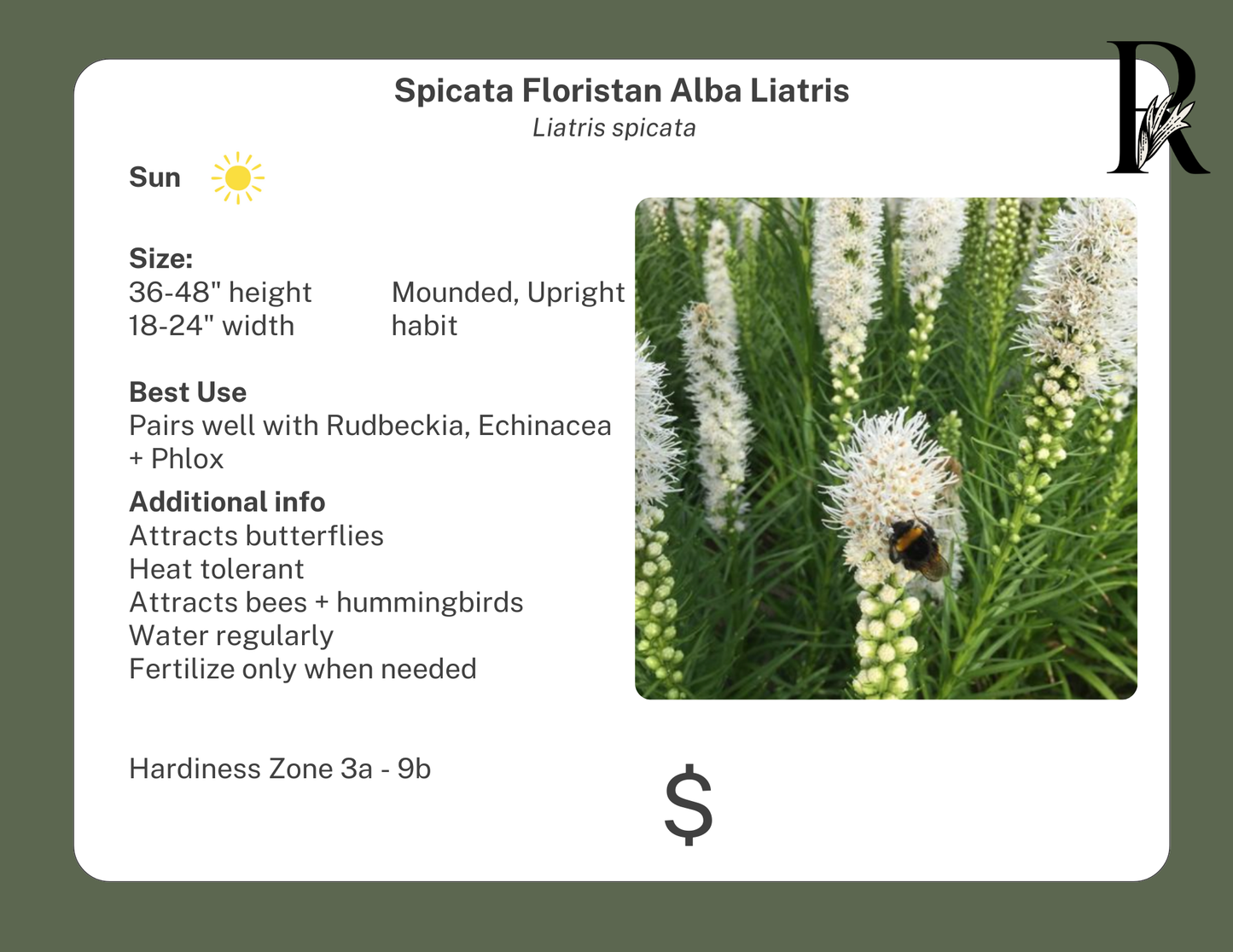Riverdene Garden Centre
White Blazing Star
White Blazing Star
Couldn't load pickup availability
Liatris ‘Floristan White’ is a cold-hardy, drought-tolerant perennial with tall, upright white flower spikes that bloom from the top down, creating a striking visual effect. It thrives in sunny, well-drained locations and is a pollinator magnet, attracting bees, butterflies, and hummingbirds. This low-maintenance plant is ideal for prairie gardens, borders, wildflower meadows, and pollinator-friendly landscapes.
Planting & Growing Conditions
- Hardiness Zone: 3-9 (extremely winter-hardy and suited for prairie climates)
- Mature Size: 2-4 feet tall, 12-18 inches wide
- Growth Rate: Moderate to fast
-
Sunlight Needs:
- Full sun (at least 6 hours of direct sunlight daily for best blooms)
- Can tolerate partial sun, but flowering may be reduced
-
Soil Requirements:
- Prefers well-drained, sandy, or loamy soil
- Tolerates poor soils but dislikes heavy clay and waterlogged conditions
- Soil pH: Neutral to slightly acidic (6.0-7.0)
- Spacing: 12-18 inches apart for proper air circulation
Watering & Maintenance
-
Young Plants (First Year):
- Water deeply 1-2 times per week until roots establish
-
Established Plants:
- Drought-tolerant, but benefits from occasional deep watering in prolonged dry spells
- Avoid overwatering, as Liatris prefers dry to medium soil moisture
-
Mulching:
- Apply a 1-2 inch layer of mulch around the base to retain moisture and suppress weeds
- Apply a 1-2 inch layer of mulch around the base to retain moisture and suppress weeds
Fertilizing
- First Year: No fertilizer needed—focus on root establishment
-
Mature Plants:
- Apply a balanced slow-release fertilizer (e.g., 10-10-10) in early spring
- Organic options include compost or aged manure
- Avoid excessive nitrogen, which encourages leggy growth and fewer flowers
Pruning & Maintenance
- Best Time to Prune: Late fall or early spring (after the seed heads have provided food for birds in winter)
-
How to Prune:
- Trim spent flower stalks down to the base after blooming
- Deadheading is optional—leaving seed heads through winter provides food for birds
- Divide clumps every 3-5 years to prevent overcrowding and encourage vigorous growth
Flowers, Foliage & Seasonal Interest
- Bloom Time: Mid to late summer (July-September)
-
Flower Color:
- Pure white, fluffy flower spikes
- Blooms from the top down, creating a dramatic vertical display
-
Foliage:
- Narrow, grass-like green leaves form a basal clump
- Upright growth habit with strong, vertical flower spikes
-
Winter Interest:
- Seed heads provide food for birds
- Dried stalks add structure to winter gardens
Pest & Disease Management
Resistant to: Deer, rabbits, and most common pests
Common Pests:
-
Aphids & Leafhoppers – Can cause minor leaf damage
- Solution: Spray with insecticidal soap or introduce ladybugs
-
Grasshoppers – May chew on foliage in dry conditions
- Solution: Encourage natural predators or apply neem oil
Common Diseases:
-
Crown Rot & Root Rot – Occurs in poorly drained soil
- Solution: Ensure well-draining soil and avoid overwatering
-
Powdery Mildew – Can develop in humid conditions
- Solution: Improve airflow and avoid overhead watering
Winter Protection
- Cold-hardy to Zone 3—no special protection needed
-
Mulching:
- Apply a light layer of mulch in late fall to protect roots in harsh winters
- Leave dried stems standing through winter for wildlife benefits and extra insulation
Landscape Uses
Perfect for wildflower meadows, prairie gardens, and naturalized plantings
Great for pollinator gardens—attracts bees, butterflies, and hummingbirds
Adds vertical interest in borders and cottage gardens
Pairs well with other sun-loving perennials like coneflowers and black-eyed Susans
Drought-tolerant and low-maintenance once established
Popular Companion Plants for ‘Floristan White’ Liatris:
- Echinacea (Purple Coneflower) – Contrasts beautifully with white Liatris
- Rudbeckia (Black-Eyed Susan) – Provides golden yellow blooms for contrast
- Sedum (Stonecrop) – Complements Liatris’ vertical growth with spreading foliage
- Ornamental Grasses (Little Bluestem, Switchgrass) – Enhances prairie-style gardens
- Asclepias (Milkweed) – Supports butterflies and native pollinators
Additional Notes:
- Lifespan: 5+ years with proper care
- Easiest propagation method: Division every 3-5 years
- Naturalizes well—will slowly spread through self-seeding if allowed
- Highly recommended for beginner gardeners due to its adaptability and resilience
Photo courtesy of Millcreek Nursery
Share




